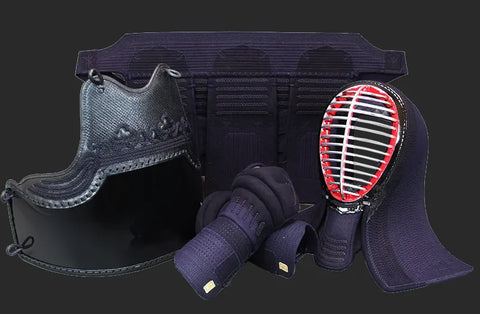We explained the difference between the ‘bu’ and ‘mm’ that are used to describe the stitching width in the previous blog.
(Click here to view the previous blog)
This time, we would like to explain about how the difference in width can change the function in a bogu.
Characteristics of kendo bogu with narrow stitching width:
The width can greatly change the function and the appearance of the bogu.
A bogu set will be more luxurious for both hand stitched and machine stitched bogu as the width gets narrow, and it requires more labour to make them.
Stitching it narrow in a consistent spacing requires high quality skill by a craftsman.
The inner padding will be evenly secured inside the futon and will turn into a nice solid bogu set.
In addition, any bogu set that stitches narrower than 1-bu or 3mm has less padding inside the futon.
The padding will get harden that a needle no longer goes through as you stitch them; thus, they reduce the amount of padding (cushion) inside.
The bogu set itself will be very durable and can be used for a long period of time because it is securely made.
It is recommended to wear it in occasions that requires you to have good appearance.
Characteristics of kendo bogu with wide stitching width:
A bogu set with a wide stitching width will be ‘fluffy’ and soft.
The padding inside the futon will function well as a cushion and it will become a bogu set that you won’t feel the pain as much.
The wider stitching will have less luxurious appearance compared to a bogu set with narrow stitching width.
These bogu sets are recommended for occasions such as practices that you will be receiving many strikes.
There is less durability since the bogu is softer; especially the parts that you receive strikes get soft faster.
The difference between a hand stitched bogu and a machine stitched bogu:
In addition to the stitching width, the stitching method will greatly change the function of a bogu.
Hand Stitched Bogu:
Hand stitched bogu uses one thread to sew both front and back side of the futon.
Thus, the spaces in between each stitching will be wider so the cushion remains and becomes an impact absorbing bogu set.
A 2-bu hand stitched bogu will have a very high impact absorption that you won’t feel any pain at all, and stay focussed in keiko.
Being softer than a machine stitched bogu is another feature about hand stitched bogu.
Machine Stitched Bogu:
Machine stitched bogu uses two threads to sew front and back side of the futon.
It sews and tighten the futon each time; thus, the futon gets harder as you sew.
Compared to a hand stitched bogu, the spacing in between each stitching is narrower so machine stitched bogu will naturally be harder.
Some machine stitched bogu are designed uniquely and have a wider stitching space.
It is called ‘pitch stitching’ and it is invented by Craftsman Suzuki, who is a craftsman working at Mitsuboshi in Japan.
‘Mine’ series are the most known selection of bogu that uses ‘pitch stitching’.
This bogu is machine stitched, but it is soft just like a hand stitched bogu; appearance, durability, pricing, comfortableness are all finely balanced.
 Mine Series Custom Made Bogu Set - Kyokuho
Mine Series Custom Made Bogu Set - Kyokuho
Stitching Width:
Narrow:
- Good appearance
- High durability
- Hard
Wide:
- Soft
- Low durability
- High impact absorption
Stitching Method:
Hand Stitch:
- Soft
- High impact absorption
Machine Stitch
- Hard
- Low impact absorption
- High durability
**There are some exceptions.
This concludes the explanation of the difference in stitching.
What type of bogu do you all wear?
Try checking out your bogu and see if your bogu suits your needs!

